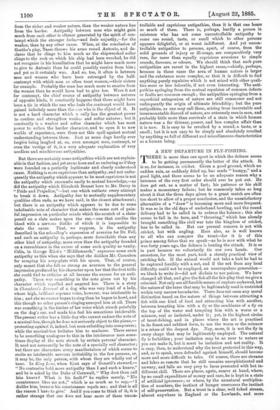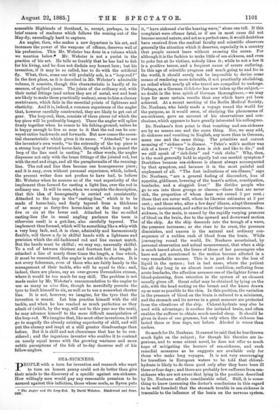A NEW DEPARTURE IN FLY-FISHING.
rrIERE is more than one sport in which the defence seems to be getting permanently the better of the attack. It is so, for instance, in cricket. Given a good ground, which no sadden rain, as suddenly dried up, has made "bumpy," and a good light, and there seems to be no adequate reason why a batsman of the very first order should ever be pat oat. He does get out, as a matter of fact; his patience or his skill makes a momentary failure; but he commonly takes so long about it that the three days given to a great match are often too short to allow of a proper conclusion, and the unsatisfactory alternative of a "draw" is becoming more and more frequent. It was so in the old days of underhand bowling, and the round delivery had to be called in to redress the balance ; this also seems to fail in its turn, and " throwing," which has already brought something like civil war into the kingdom of cricket, has to be called in. But our present concern is not with cricket, but with angling. Here also, as is well known to all who can compare the trout—for it is of this prince among fishes that we speak—as he is now with what he was forty years ago, the defence is beating the attack. It is so in part because we voluntarily tie our owa hands. Our ancestors, for the most part, took a sternly practical view of catching fish. If the animal would not take a bait he had to be captured forcibly with a net, and if the net from any local difficulty could not be employed, an unscrupulous generation— we blush to write it—did not disdain to use poison. We have changed all that, and give the fish all the fair-play that we give a criminal. Not only are all forcible means of capture eschewed, but the nature of the lures that may be legitimately used is restricted within very narrow boundaries. There does not seem any moral distinction based on the nature of things between attracting a fish with one kind of food and attracting him with another, between tempting him with a fly or the semblance of a fly on the top of the water and tempting him with a worm or a minnow, real or imitated, under it ; yet, in the highest circles of trout-fishing, and in places where the art is practised in its finest and subtlest form, to use the worm or the minnow is a crime of the deepest dye. Nay, more, it is not the fly in every shape that may be legitimately employed. The natural fly is forbidden ; your imitation may be as near to nature as you can make it, but it must be imitation and not reality. It is easy, then, to understand why the trout protected in this way, and, so to speak, even defended against himself, should become more and more difficult to take. Of course, there are streams and lakes so remote that he still remains unsophisticated and unwary, and falls an easy prey to lures presented with but in- different skill. There are places, again, nearer at hand, where, by no small expenditure of money and care, he is kept in a state of artificial ignorance; or where, by the unnatural multiplica- tion of numbers, the instinct of hunger overcomes the instinct of self-preservation. But a trout in a clear, well fished stream, almost anywhere in England or the Lowlands, and more
accessible Highlands of Scotland, is, except, perhaps, in the brief season of madness which follows the coming out of the May-fly, exceedingly hard to capture.
An angler, then, who makes a new departure in his art, and increases the power of the weapons of offence, deserves well of his profession. This Mr. Webster has done in a volume which we mention below" Mr. Webster is not a purist in the practice of his art. He tells us frankly that he has had to fish for his living, and he does not disdain any honest lure ; but his invention, if it may be so called, has to do with the artificial fly. What, then, some one will probably ask, is a " loop-rod P" In the first place, as it is described in Mr. Webster's admirable volume, it consists, though this characteristic is hardly of its essence, of spliced pieces. The joints of the ordinary rod, with their metal fittings (and unless they are of metal, wet and heat are likely to make them practically useless), seem to him a clumsy contrivance, which fails in the essential points of lightness and elasticity. And it is, indeed, a common experience of the angler that, however carefully constructed, they are likely to get out of gear. The loop-rod, then, consists of three pieces (of which the top piece will be preferably longer). These the angler will splice firmly together when he comes to his fishing-ground, unless he is happy enough to live so near to it that the rod can be con- veyed entire backwards and forwards. But now comes the essen- tial characteristic which gives it its name. "Attached," to use the inventor's own words, "to the extremity of the top piece is a strong loop of twisted horse-hair, through which is passed the loop of the line used in casting." In other words, the angler dispenses not only with the brass fittings of the jointed rod, but with the reel and rings, and all the paraphernalia of the running- line. The rod and line then become one homogeneous piece; and it is easy, even without personal experience, which, indeed, the present writer does not profess to have had, to believe Mr. Webster when he assures us of the vast superiority of the implement thus formed for casting a light line, over the rod in ordinary use. It will be seen, when we complete the description, that this idea of homogeneity is carried out consistently. Attached to the loop is the "casting-line," which is to be made of horse-hair, and finely tapered from a thickness of as many as forty-five horse-hiirs at the loop end to five or six at the lower end. Attached to the so-called casting-line (for in usual angling parlance the term is otherwise used) is a gut-line, also carefully tapered. The implement thusiormed, which will be something like a whip with a very long lash, and, it is clear, admirably and harmoniously flexible, will throw a fly in skilful hands with a lightness and precision which the old-fashioned rod and line cannot match. Bat the hands mast be skilful ; we may say, unusually skilful. To a rod of between thirteen and fourteen feet in length is attached a line of nearly three times the length, a line which, it must be remembered, the angler is not able to shorten. It is not every fisherman, even of those who are fairly handy in the management of their tackle, who will be equal to this ; and, indeed, there are places, say an over-grown Devonshire stream, where it would be too much for any skill. The problem is not made easier by Mr. Webster's recommendation to the angler to use as many as nine flies, though he mercifully permits the tyro to limit himself to six, as well as to use a somewhat shorter line. It is not, however, we imagine, for the tyro that the invention is meant. Let him practise himself with the old tackle, and when he has reached as much perfection as they admit of (which, by the way, will not be this year nor the next), he may advance himself to the more difficult manipulation of the loop-rod. We imagine that, like most other inventions, it will go to magnify the already existing superiority of skill, and will put the clumsy and inapt at a still greater disadvantage than before. But it is skill and not clumsiness that has to be con- sidered; and the ingenious inventor who enables it to contend on nearly equal terms with the growing wariness and more subtle perceptions of the fish of to-day deserves well of his fellow-anglers.



































 Previous page
Previous page